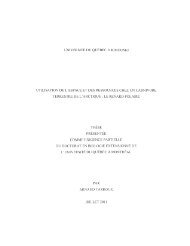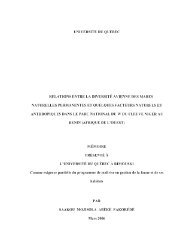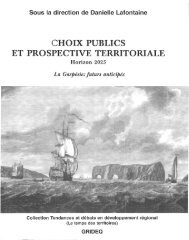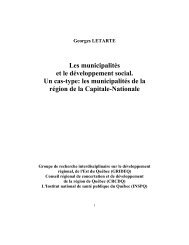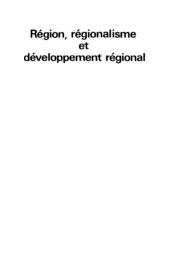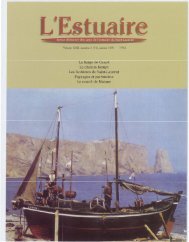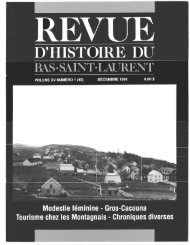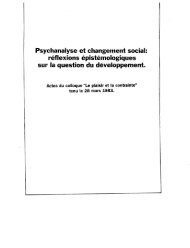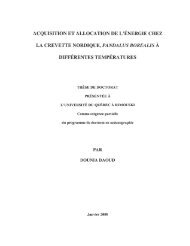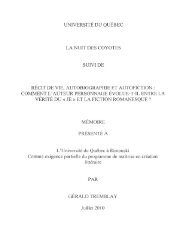influence du climat et de la prédation sur l'utilisation de l'habitat et la ...
influence du climat et de la prédation sur l'utilisation de l'habitat et la ...
influence du climat et de la prédation sur l'utilisation de l'habitat et la ...
Create successful ePaper yourself
Turn your PDF publications into a flip-book with our unique Google optimized e-Paper software.
3<br />
L ' importance re<strong>la</strong>tive <strong>de</strong>s facteurs dépendants <strong>et</strong> indépendants <strong>de</strong> <strong>la</strong> <strong>de</strong>nsité dans <strong>la</strong><br />
déterminati on <strong>de</strong> l'abondance <strong>de</strong>s popu<strong>la</strong>tions a été longtemps discutée en écologie (e.g.<br />
Davidson & A ndrewartha 1948, Nicholson 1954, Hairston <strong>et</strong> al. 1960, Doug<strong>la</strong>s & Lesli e<br />
1986, Forchhammer <strong>et</strong> al. 1998, Barbraud & Weimerskirch 2003, Berryman & Lima 2006).<br />
On sait maintenant que les <strong>de</strong>ux types <strong>de</strong> facteurs peuvent avoir <strong>de</strong>s eff<strong>et</strong>s importants, <strong>et</strong><br />
peuvent interagir pour détenniner l'abondance <strong>de</strong>s popu<strong>la</strong>ti ons (Sa<strong>et</strong>her 1997, Gail<strong>la</strong>rd <strong>et</strong> a l.<br />
2000).<br />
Le <strong>climat</strong> <strong>influence</strong> <strong>la</strong> dynamique <strong>de</strong>s popu<strong>la</strong>ti ons animales par <strong>de</strong>s eff<strong>et</strong>s directs <strong>sur</strong> <strong>la</strong><br />
physiologie <strong>de</strong>s indivi<strong>du</strong>s (coüts <strong>de</strong> thermorégul ati on, coüts <strong>de</strong> locomoti on), ou par <strong>de</strong>s eff<strong>et</strong>s<br />
indirects en modifiant <strong>la</strong> nature <strong>de</strong>s interactions biologiques (compétition, re<strong>la</strong>tions<br />
prédateurs-proies, accès à <strong>la</strong> nourriture). Dans un système à trois niveaux trophiques<br />
(végétation, herbivore, carnivore, F ig. l.l), chaque ni veau peut voir son abondance modi fiée<br />
par les eff<strong>et</strong>s <strong>du</strong> <strong>climat</strong> <strong>et</strong> <strong>de</strong> <strong>la</strong> <strong>de</strong>nsité, ainsi que par une modi ficati on <strong>de</strong>s interacti ons<br />
trophiques (<strong>du</strong>e par exemple à un impact <strong>du</strong> <strong>climat</strong> <strong>sur</strong> l'efficacité <strong>de</strong> chasse <strong>de</strong>s prédateurs<br />
ou <strong>sur</strong> l'accessibilité <strong>de</strong> <strong>la</strong> végétati on pour les herbivores). Ainsi, <strong>la</strong> <strong>sur</strong>vie <strong>de</strong>s ori gnaux<br />
(A lces alces) à l'île Royale (É.U.) est plus faible les années <strong>de</strong> fo rt enneigement à <strong>la</strong> fo is<br />
parce que <strong>la</strong> mortalité <strong>de</strong>s indivi<strong>du</strong>s âgés augmente, <strong>et</strong> parce que les loups gris (Canis lupus)<br />
augmentent leur efficacité <strong>de</strong> chasse (en chassant en plus grands groupes) quand <strong>la</strong> neige est<br />
profon<strong>de</strong> (Post <strong>et</strong> al. 1999b). Les interacti ons trophiques sont donc <strong>de</strong>s voies par lesquell es<br />
les eff<strong>et</strong>s <strong>du</strong> <strong>climat</strong> peuvent se propager à tout un écosystème (Fig. 1.1 ).<br />
Une approche souvent utilisée pour prédire les eff<strong>et</strong>s <strong>de</strong>s changements <strong>climat</strong>iques est <strong>de</strong><br />
modéliser le <strong>climat</strong> futur, d ' en dé<strong>du</strong>ire <strong>la</strong> répartition <strong>de</strong> <strong>la</strong> végétation, puis <strong>la</strong> composition <strong>de</strong><br />
<strong>la</strong> communauté animale (Schmitz 2003). C<strong>et</strong>te approche a pour inconvénient <strong>de</strong> négli ger les<br />
eff<strong>et</strong>s potentie ls <strong>du</strong> <strong>climat</strong> <strong>sur</strong> les interactions entre espèces (Davis <strong>et</strong> al. 1998, Wilmers &<br />
Post 2006, Suttle <strong>et</strong> al. 2007), <strong>et</strong> notamment <strong>sur</strong> les interacti ons entre prédateurs <strong>et</strong> proies qui<br />
sont sensibles aux conditions environnementales (Post <strong>et</strong> al. 1999b, Hebblewhite 2005,<br />
Lensing & Wise 2006, Wilmers <strong>et</strong> al. 2006).



